
ISSN: 2321 9653; IC Value: 45.98; SJ Impact Factor: 7.538 Volume 10 Issue XI Nov 2022 Available at www.ijraset.com



ISSN: 2321 9653; IC Value: 45.98; SJ Impact Factor: 7.538 Volume 10 Issue XI Nov 2022 Available at www.ijraset.com

Sneha S1, Sumitha2 1, 2Dr. SNS Rajalakshmi College of Arts and Science
A and B are two idle communities, and I is a relation between A and B.
Definition 1. [8] The ordered trinity S = (A,B,I) , where A B = ,I A B is called the incidence structure. If A and B are separate sets (disjuncts), and I is a double (binary) connection connecting A and B, then S = (A, B, I) is the structure of incidence. This relation is also known as the incidence relation. The two components of a A are referred to as community dots and are denoted by lowercase letters of the alphabet, whereas the community blocks (or straight lines) of a X are denoted by capital letters of the alphabet. We shall read: "The fact (X,Y)I can be denoted by p I Y as in any double bond." Block Y has incident point X, or point X has incident block Y. The incidence bond I of a finite set, like any double bond between two finite sets
Definition 1: Let S represent the incidence structure with v points and b blocks, where A={X1,X2,X3,……….Xv} and B={Y1,Y2,Y3,………Yb}.
Matrix
A= (aij)= 1, 0, the incidence matrix for the structure S is known as. The incidence matrix A is a reflection from PB 0,1, i.e., (p, X) 1 if p I X and (p, X) 0 if p X (p is not an incident with X), i.e., A =(aij)vxb.
The following is how to get this matrix: On the left side of a rectangular table, the arrival set X with its k blocks is positioned above the starting set P with its v points. When (Pi, bj)I is marked as 1, the empty rows and columns of the table are filled with 1, and when (Pi, bj)I not element I is marked as 0, they are filled with 0, accordingly. The resulting matrix, which has v k, is the incidence matrix. Through its incidence matrix, a finite structure's nature can be investigated. It is obvious that the power of the point Pi is equal to the sum of the 1s in its ith row, whereas the power of the block bj is equal to the sum of the 1s in its jth column.

Example 1
Let be S= (A,B,Ꜫ) a finite structure with: A={ 1,2,3,4,4,5,6,7} and B={b1,b2,b3,b4,b5,b6,b7} where b1=(1,3,4), b2=(1,4,7), b3=(4,5,7), b4=(3,4,6), b5=(2,4,7), b6=(1,5,3), b7=(2,4,6) The incidence matrix for this structure will be:
ts regular structure may be seen from the fact that each row has 3 units and all points have the same power r = 3. But because there are three units in each column, it is also uniform. The setup is tactical as a result.
ISSN: 2321 9653; IC Value: 45.98; SJ Impact Factor: 7.538 Volume 10 Issue XI Nov 2022 Available at www.ijraset.com

Let G be a graph with n vertices, m edges and without self loops. The incidence matrix of is an × matrix = [ ], whose rows correspond to the vertices and the columns correspond to edges such that:
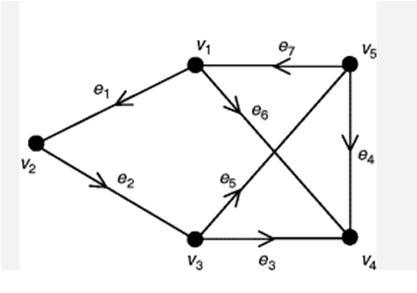

A=(aij)= 1, 0, ℎ It is also called vertex edges incidence matrix and is denoted by A(G). Example 2: Consider the graph given the figures: (i) G1
The incidence matrix is G1 is A(G1)=M1= ⎣ ⎢ ⎢ ⎢ ⎡1 1 1 0 0 0 0 0 0 1 1 1 0 1 1 0 0 0 0 1 1 0 0 0 0 0 0 0 0 0 1 1 0 0 0 0 1 1 0 0⎦ ⎥ ⎥ ⎥ ⎤ (ii) G2 The incidence of the matrix G2 is A(G2)=M2= ⎣ ⎢ ⎢ ⎢ ⎡1 0 0 0 0 1 1 1 1 0 0 0 0 0 0 1 0 0 1 0 0 0 0 1 1 0 1 0 0 0 0 1 1 0 1⎦ ⎥ ⎥ ⎥ ⎤
Let be a graph and let ( ) be its incidence matrix. Now each row in ( ) is a vector over (2) in the vector space of graph . Let the row vectors be denoted by 1, 2, . . . , . Then,
A(G)= ⎣ ⎢ ⎢ ⎢ ⎡ 1 2 . . ⎦ ⎥ ⎥ ⎥ ⎤
The sum of these vectors is zero since there are precisely two 1s in each of the columns of A. (this being a modulo 2 sum of the corresponding entries). As a result, the vectors A1, A2,..., and An are linearly dependent. Consequently, give A a n. Consequently, rank A n 1 [2]
Assume that H is a subgraph of graph G and that A(H) and A(G) are their respective incidence matrices. It is obvious that A(H) is a submatrix of A(G), maybe with permuted rows or columns. We find that each of the n k submatrices of A(G) corresponds to a subgraph of G with k edges, where k is a positive integer, k m, and n is the number of vertices in G. Theorem 1. [4] Let ( ) be the incidence matrix of a connected graph with vertices. = ( − 1) × ( − 1) submatrix of ( ) is non singular if and only if the − 1 edges corresponding to the − 1 columns of this matrix constitutes a spanning tree in The following is another form of incidence matrix.
Definition 4.[2] The matrix = [ ] of the graph = ( , ) with = { 1, 2, . . . , } and = { 1, 2, . . . , }, is the × matrix associated with a chosen orientation of the edges
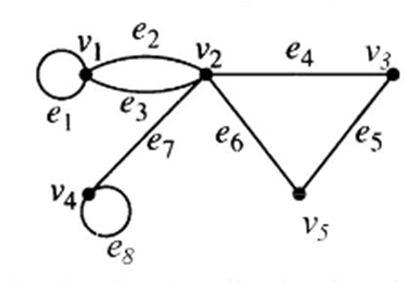
ISSN: 2321 9653; IC Value: 45.98; SJ Impact Factor: 7.538 Volume 10 Issue XI Nov 2022 Available at www.ijraset.com

of in which for each = ( , ), one of or is taken as positive end and the other as negative end, and is defined by: fij= 1, 1 , 1, 1 ℎ , 0, 1 ℎ .
This matrix can also be obtained from the incidence matrix by changing either of the two 1 to −1 in each column. The above arguments amount to arbitrarily orienting the edges of , and is then the incidence matrix of the oriented graph. The matrix is then the modified definition of the incidence matrix .

EXAMPLE 3:
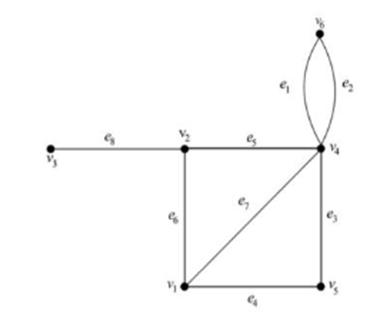
Consider the graph G shown in figure with v={v1,v2,v3,v4} and E={e1,e2,e3,e4}.
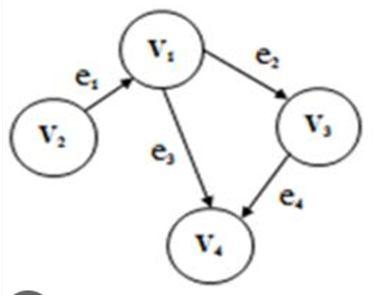
SOLUTION:
The incidence matrix is given by:
A(G)= 1 1 1 0 1 0 0 0 0 1 0 1 0 0 1 1 F=(fij)= 1 1 1 0 1 0 0 0 0 1 0 1 0 0 1 1 Let the graph have medges and let be the number of different cycles in
Definition 5:
The cycle matrix = [ ]× of is a (0, 1) − matrix of order × , with = 1, if the ℎ cycle includes ℎ edge and = 0, otherwise. The cycle matrix of a graph is denoted by ( ). Example 4: Consider the graph G given in figure .
The graph G has 4 different cycles: X1={e1,e2}, X2={e3,e4,e5,e6}, x3={e3,e4,e7} and x4={e5,e6,e7}. The cycle matrix is: C(G)= ⎣ ⎢ ⎢ ⎢ ⎢ ⎡0 0 0 1 0 1 1 0 0 0 0 0 1 1 0 1 0 0 0 0 0 0 0 1 1 1 1 0 1 0 1 0 0 0 1 1 0 0 0 0 1 1 0 0 0 0 0 0⎦ ⎥ ⎥ ⎥ ⎥ ⎤
Theorem 2. If G is a graph without self loops and has the incidence matrix A and cycle matrix C with the same order of edges for the columns, then every row of C is orthogonal to every row of A, i.e., AC T = CA T 0 (mod2), where A T and C T are the transposes of A and C, respectively. We use the following example to demonstrate the aforementioned theorem
ISSN: 2321 9653; IC Value: 45.98; SJ Impact Factor: 7.538 Volume 10 Issue XI Nov 2022 Available at www.ijraset.com


Clearly, A(G)= ⎣ ⎢ ⎢ ⎢ ⎢ ⎡1 1 0 0 0 0 0 0 1 1 1 0 0 1 1 0 0 0 1 1 0 0 0 0 0 0 0 1 1 0 1 1 0 0 0 0 1 1 0 0 0 0 0 0 0 0 0 1⎦ ⎥ ⎥ ⎥ ⎥ ⎤ and C(G)= 1 1 0 0 0 0 0 0 0 0 1 1 0 0 1 0 0 0 0 0 1 1 1 0 0 0 1 1 1 1 0 1 A. = ⎣ ⎢ ⎢ ⎢ ⎢ ⎡1 1 0 0 0 0 0 0 1 1 1 0 0 1 1 0 0 0 1 1 0 0 0 0 0 0 0 1 1 0 1 1 0 0 0 0 1 1 0 0 0 0 0 0 0 0 0 1⎦ ⎥ ⎥ ⎥ ⎥ ⎤ ⎣ ⎢ ⎢ ⎢ ⎢ ⎢ ⎢ ⎡1 0 0 0 1 0 0 0 0 1 0 1 0 1 0 1 0 0 1 1 0 0 1 1 0 1 1 0 0 0 0 0⎦ ⎥ ⎥ ⎥ ⎥ ⎥ ⎥ ⎤ = ⎣ ⎢ ⎢ ⎢ ⎢ ⎡2 0 0 0 2 2 2 2 0 2 0 2 0 2 2 2 0 0 2 2 0 0 0 0⎦ ⎥ ⎥ ⎥ ⎥ ⎤ =2 ⎣ ⎢ ⎢ ⎢ ⎢ ⎡1 0 0 0 1 1 1 1 0 1 0 1 0 1 1 1 0 0 1 1 0 0 0 0⎦ ⎥ ⎥ ⎥ ⎥ ⎤ ≡ (mod 2) ………………………(1) C. =
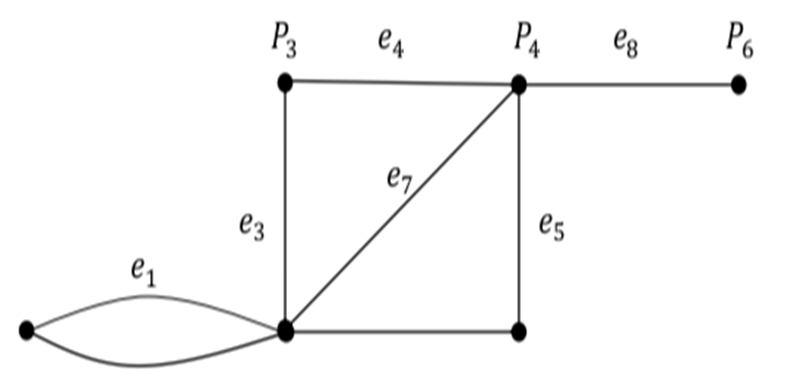
1 1 0 0 0 0 0 0 0 0 1 1 0 0 1 0 0 0 0 0 1 1 1 0 0 0 1 1 1 1 0 1 ⎣ ⎢ ⎢ ⎢ ⎢ ⎡1 1 0 0 0 0 0 0 1 1 1 0 0 1 1 0 0 0 1 1 0 0 0 0 0 0 0 1 1 0 1 1 0 0 0 0 1 1 0 0 0 0 0 0 0 0 0 1⎦ ⎥ ⎥ ⎥ ⎥ ⎤ =
1 1 0 0 0 0 0 0 0 0 1 1 0 0 1 0 0 0 0 0 1 1 1 0 0 0 1 1 1 1 0 1 . ⎣ ⎢ ⎢ ⎢ ⎢ ⎢ ⎢ ⎡1 1 0 0 0 0 1 1 0 0 0 0 0 1 1 0 0 0 0 0 1 1 0 0 0 0 0 1 1 0 0 1 0 0 1 0 0 1 0 1 0 0 0 0 0 1 0 1⎦ ⎥ ⎥ ⎥ ⎥ ⎥ ⎥ ⎤ =
2 2 0 0 0 0 0 2 2 2 2 0 0 2 2 2 2 0 0 2 2 2 2 0 =2 1 1 0 0 0 0 0 1 1 1 1 0 0 1 1 1 1 0 0 1 1 1 1 0
ISSN: 2321 9653; IC Value: 45.98; SJ Impact Factor: 7.538

Volume 10 Issue XI Nov 2022 Available at www.ijraset.com
≡ 0( mod 2) …………………………..(2)
From (1) and (2) drives: A. =C. ≡0( 2).
Definition 4. [1] Let G be a graph with m edges and cutsets. The cut set matrix = [ ]× of is a (0,1) matrix with = { 1, ℎ − ℎ , 0, ℎ .
Example 6. Consider the graphs shown in figure

From the procedure, the fundamental cut sets of the above graph are,
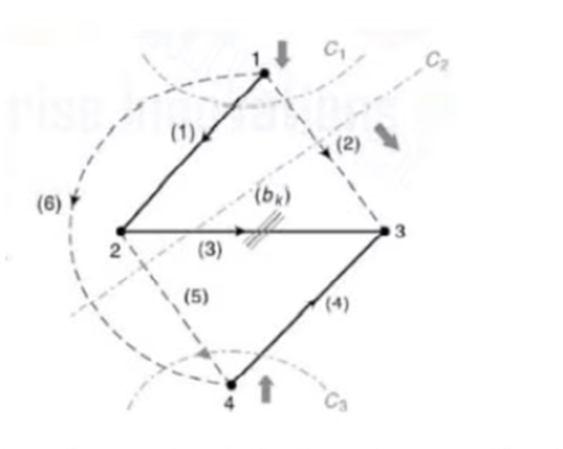
C1: {1,2,6}
C2: {2,3,5,6}
C3= {4,5,6}
[Qij]= 1 1 0 0 0 1 0 1 1 0 1 1 0 0 0 1 1 1
The incidence matrix represents the relation of an incidence of a finite structure = ( , ,). The incidence matrix graph is easily constructed, based only on its definition. Incidence matrices are applied in many scientific fields such as: telecommunications, graph theory, coding theory, computer science, statistics, etc. The matrix A has been defined over a field, Galois field modulo 2 or GF(2), that is, the set {0, 1} with operation addition modulo 2
[1] Narsingh Deo, Graph theory with applications to engineering &computer science, Universitet Central Florida, 2016.
[2] Frank Harary, graphs and matrices, Vol.9, No.1, Jan.,1967, pp.83 90.
[3] Graph theory, https://docplayer.net/24606361 10 graph matrices incidence matrix.html
[4] L.R Foulds, Graph theory application, New York 1992 puplisher springer,
[5] Veerendra Vikram Awasthi, Mohanpur, West Bengal, 741 252, INDIA.
